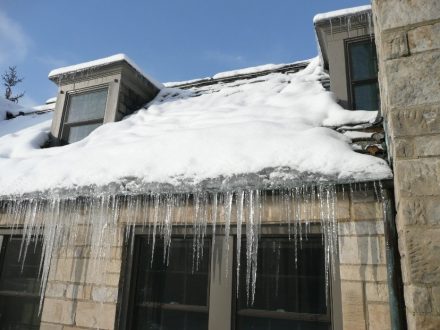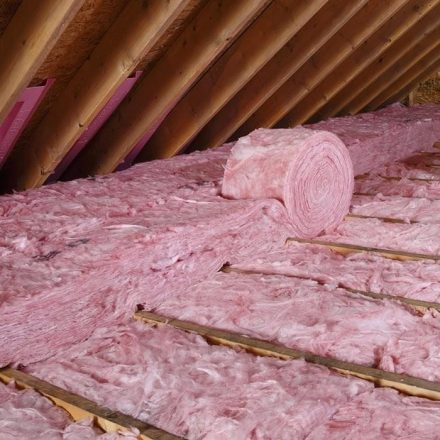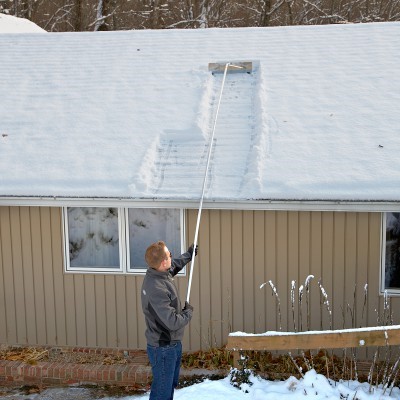
Although icicles may look nice hanging off of your house, they are a warning sign for potential problems.
Although icicles may look nice hanging off of your house, they are a warning sign for potential problems. The same conditions that allow icicles to form also lead to ice dams. An ice dam is a continuous chunk of ice that forms at the edge of a roof and prevents water created by melting snow from draining off the roof.
For the most part, while frozen, the biggest threat an ice dam poses is potentially tearing off gutters. However, once the snow on your roof starts melting, the water that backs up as a result of the dam can leak into a home and cause damage to walls, ceilings, insulation, and other areas. This in turn can cause peeling paint, warped floors, stained and sagging ceilings, soggy attic insulation, mold, and mildew.
What Causes Ice Dams?
The formation of an ice dam is an interesting process. First, heat collects in the attic and warms the roof, except at the eaves. Next, snow melts on the warm roof and the water flows down on the cold eaves and freezes. Lastly, ice builds up along the eaves, forming a dam. The snow on the warm roof continues to melt, water continues to flow down to the newly formed dam, and backs up behind it. This water finds cracks and openings in the exterior roof covering and flows into the attic space. From the attic it could flow into exterior walls or through the ceiling insulation and stain the ceiling finish.
Preventing Ice Dams
There is one essential must for preventing ice dams: keep the entire roof the same temperature as the eaves. This is possible by increasing ventilation, adding insulation, and sealing off any air leaks that could warm the underside of the roof.
The following tips will help you prevent ice dams from forming and as a side effect, help you use less energy. As with any other work done on your house, when in doubt, consult a professional.
1. Attic Ventilation
Attic ventilation brings in cold outdoor air and flushes out warmer attic air, cooling the attic and the roof as a result. The minimum size of the openings should be about 1 sq. ft. of vent for every 300 sq. ft. of ceiling area.
2. Stop Leaks
On average, about one-third of heat loss is through the ceiling into the attic. Most of the loss comes from air leaks from unblocked walls, gaps in drywall, and cracks around light fixtures, plumbing pipes, chimneys, and access hatches. You’ll have to climb into your attic and move insulation out of the way, to plug the leaks using foam, caulk and other methods. Always wear protective clothing (dust mask, long-sleeved shirt, long pants) to help prevent skin irritations from the insulation.
3. Exhaust to the Outside
Make sure the ducts connected to the kitchen, bathroom, and dryer vents all lead outside through either the roof or walls, but not through the soffit. This will prevent excess warm air from being sent to the attic and will prevent mold growth during warmer weather.
4. Add Insulation
More insulation on the attic floor keeps the heat where it belongs. While you’re in the attic, check the depth of your insulation. If you have less than 8 in. and have had ice dam problems before, add more insulation. This can be done on your own, but for the best quality job, it’s usually worth hiring a professional; you most likely won’t save much by doing it yourself.

More insulation on the attic floor keeps the heat where it belongs.
Dealing with an Ice Dam
Most of the damage done by an ice dam (besides potentially ripping down gutters) is from the leaks it may cause. If you can’t find any signs of leakage, you may not have to do anything. When the weather gets warmer, just implement the prevention strategies listed earlier.
If you do have leakage from an ice dam, consider hiring a snow removal professional to clear your roof. This is the safest way to go about dealing with the problem. If hiring someone is not an option for you, there are a few things you can do.
Cool Down the Attic
Trying to get rid of ice dams with a hammer or chisel is bad for your roof and dangerous. Instead, deal with the problem that causes ice dams: A warm attic.
Put a box fan in the attic and aim at the roof where water is actively leaking in. The directed flow of cold air will help slow and even stop the melting of snow.
Rake It
Pull off snow with a long-handled roof rake from the ground. Using a rake with wheels, will help remove the snow without damaging shingles.

Using a rake with wheels, will help remove the snow without damaging shingles.
De-ice It
The main problem with ice dams is leakage caused from water backing up. One way to fix this is to fill an old pair of panty hose with a calcium chloride ice melter. Place it onto the roof so it crosses the ice dam and hangs over the gutter. The calcium chloride will slowly melt through the snow and ice and create a canal for water to flow down into the gutters or off the roof.
If you notice that water is leaking into your home, try to collect dripping water in buckets or pans. Mop up any excess water on the floor and move furniture and valuables away from the area to prevent them from being damaged.
Here at Lantz Family Insurance Agency we are committed to providing our clients with quality insurance and superior customer service – including when disaster strikes. Should the need arise to file a claim, we’re ready to assist you in any way we can. Call us for a FREE, No Obligation Quote at 774-992-0789 or email info@lantzfia.com.

Peter C. Lantz, Owner/Agent
Peter C. Lantz (Pete) has been a Licensed Insurance Agent in Massachusetts for more than 10 years. He has worked for Arbor Insurance Brokerage, Inc. and USA Wealth Group, Inc. as an Insurance Broker and Financial Advisor. Pete has served in the United States Marine Corps Reserve. Pete has his Real Estate Brokers’ License, as well as Life and Health Insurance Licenses.
